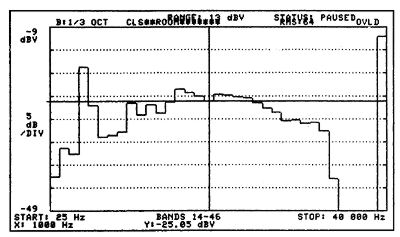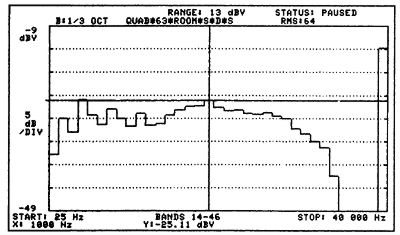| Columns Retired Columns & Blogs |
MartinLogan CLS loudspeaker 1987 Measurements
Sidebar 1: 1987 Measurements
Looking at the amplifier load factor, the impedance curve (fig.1) is typically "electrostatic." Low at low frequencies, and with no visible signs of the 50Hz diaphragm resonance, it climbs steeply to a harmless 33 ohms by 1kHz. Above this level, the load is almost purely capacitive, falling with frequency at 6dB/octave, reaching 2.5 ohms at 10kHz, and finally bottoming out at a value of 1.6 ohms at 20kHz. Wide-band synthesizers played at high level will not do the amplifier-speaker combination much good, while this load non-uniformity will cause more treble balance variations than usual with different cables and different amplifiers. In fact, one or two power amps may not be too stable with this load under heavy transient drive.

Fig.1 MartinLogan CLS, electrical impedance (solid) and phase (logarithmic vertical div.).
The CLS frame assembly seemed to show a minor mechanical resonance which was checked out acoustically (fig.2) and clearly placed at 160Hz. This resonance could be picked out on nearly all response curves taken.

Fig.2 MartinLogan CLS, frame resonance.
The forward response set is shown in fig.3. Taking the solid axial line first, the speaker output was high in the midrange, partly due to proximity. Above 1kHz, the output was even and well-extended, suggesting a basically good tonal balance. No loss was seen by 20kHz. The low frequencies also deserve some comment. As predicted by Gayle Sanders of MartinLogan, the main resonance was precisely at 50Hz, and, in my view, showed excessive amplitude. The bands above 50Hz were deficient, while a steep rolloff held below 50Hz, the output already -8dB by 40Hz, and -18dB by 30Hz.

Fig.3 MartinLogan CLS, 1/3-octave response on listening axis at 1m (solid), off-axis response in the vertical (small-dashed) and horizontal (long-dashed and dot-dashed) planes.
Given the smoothing advantage provided by 1/3-octave analysis, the off-axis responses of the CLS were remarkably good. It held a well-extended response over a wide range of angles, ±15 degrees vertical and up to 45 degrees horizontally. This is shown by the commendable closeness of the off-axis response group.
To explore the subjective comment of "phasiness," a narrow-band analysis was performed in the 500Hz-20.5kHz range for the axial response, and for a small 5 degrees lateral angle change (fig.4). The results show that the CLS does have a peak at 15-16kHz (heard on audition), and that the two responses, although subjectively alike, do not correlate well. Inter-response differences of 3-5dB are frequent at high frequencies which, of necessity, implies quite rapid phase shifts. These effects are typical of a multi-sourced, multi-lobed treble radiating system—the multiple cell configuration.

Fig.4 MartinLogan CLS, narrow-band analysis of on-axis response (top) and 15 degrees off-axis to the side (bottom).
The computer-averaged room response (fig.5) provides the final stage of measurement analysis. Here the 50Hz resonance can be clearly seen, while the energy loss above 60Hz is also apparent. The broad midrange is well balanced, while the upper treble is a little too well-extended at the highest extremity, suggesting an aural "edge" or corner. This is associated with the 16kHz axial prominence.

Fig.5 MartinLogan CLS, 1/3-octave, spatially averaged response in MC listening room.
Without claiming sonic superiority for the Quad ESL-63, the response for this model under identical conditions (fig.6) makes for an interesting comparison. Quad has attained a commendably uniform bass to 30Hz, with a broad sweep of uniform output held over the entire range, culminating in a naturally smooth room-energy rolloff in the highest frequencies. Yes, it can be done!

Fig.6 Quad ESL-63, 1/3-octave, spatially averaged response in MC listening room.
The CLS offered a below-average sensitivity of 84dB/W, with a power handling of 100W per channel. Maximum room sound-levels of typically 100dBA will be possible, though the speaker generally seemed to sound a mite louder than that.—Martin Colloms
- Log in or register to post comments




































